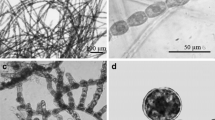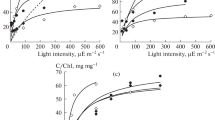Summary
Autotrophic cultures of Euglena in continuous light (LL) were exposed to temperature cycles spanning different temperature intervals in the physiological range. Each cycle consisted of a regular alternation between equal phases of two temperatures differing by 7°. Different temperature combinations varied in the degree to which they were capable of phasing cell division. The most effective combinations tested, 18/25° and 28/35°, produced almost as good a synchrony as has been observed from the use of light/dark cycles (at constant temperature) in this system. Both batch and chemostat cultures with a wide range of generation times were phased, and cycles with period lengths ranging from 8 to 24 hr appeared to be equally effective.
Dry weight of cells per milliliter of sample was found to increase uniformly in phased cultures, indicating that most biosynthetic processes continue in such cultures even while all division is inhibited. Phasing cannot, therefore, be explained as a simple growth inhibition by the less favorable temperature of the cycle.
The average generation times of cultures phased by 12,12 hr cycles were shorter than the “expected” times calculated from the results of the corresponding pairs of constant temperature experiments, indicating that temperature cycles have an overall accelerating effect on the growth of Euglena in continuous light. This and other evidence suggests that temperature cycles may be acting as Zeitgeber for Euglena in LL even though many trials revealed no persistence of a cell division rhythm in conditions of constant temperature and LL following temperature-cycle entrainment.
Similar content being viewed by others
References
Blum, J. J., Padilla, G. M.: Studies on synchronized cells; the time course of DNA, RNA, and protein synthesis in Astasia longa. Exp. Cell Res. 28, 512–523 (1962).
Brinkmann, K.: Temperatureinflüsse auf die circadiane Rhythmik von Euglena gracilis bei Mixotrophie und Autotrophie. Planta (Berl.) 70, 344–389 (1966).
Bruce, V. G.: Environmental entrainment of circadian rhythms. Cold Spr. Harb. Symp. quant. Biol. 25, 29–48 (1960).
—: Cell division rhythms and the circadian clock. In: Circadian clocks (J. Aschoff, ed.), p. 125–138. Amsterdam: North-Holland 1965.
Bünning, E.: The physiological clock. Berlin-Göttingen-Heidelberg: Springer 1964.
Buetow, D. E., Levedahl, B. H.: Decline in the cellular content of RNA, protein, and dry weight during the logarithmic growth of Euglena gracilis. J. gen. Microbiol. 28, 579–584 (1962).
Cook, J. R.: Light-induced division synchrony of Euglena gracilis, and the effects of visible light on related cells. Doct. dissert. Univ. of Calif., Los Angeles (1960).
—: The cultivation and growth of Euglena. In: The biology of Euglena, I. (D. E. Buetow, ed.), p. 243–314. New York: Academic Press 1968.
— James, T. W.: Light-induced division synchrony of Euglena gracilis. Exp. Cell Res. 21, 583–589 (1960).
Cramer, M., Myers, J.: Growth and photosynthetic characteristics of Euglena gracilis. Arch. Microbiol. 17, 384–402 (1952).
Edmunds, L. N., Jr.: Physiological and metabolic aspects of synchronously dividing cultures of Euglena gracilis Klebs (Z) in relation to the problem of circadian rhythms. Doct. dissert., Princeton Univ., Princeton, N.J. 1964.
—: Studies on synchronously dividing cultures of Euglena gracilis Klebs (strain Z). I. Attainment and characterization of rhythmic cell division. J. cell. comp. Physiol. 66, 147–158 (1965a).
Edmunds, L. N.: Studies on synchronously dividing cultures of Euglena gracilis Klebs (strain Z). II. Patterns of biosynthesis during the cell cycle. J. cell. comp. Physiol. 66, 159–182 (1965b).
—: Studies on synchronously dividing cultures of Euglena gracilis Klebs (strain Z). III. Circadian components of cell division. J. cell. comp. Physiol. 67, 35–44 (1966).
Edmunds, L. N.: Persisting circadian rhythm of cell division in Euglena: Some theoretical considerations and the problem of inter-cellular communication. In: Symposium on biochronometry (M. Menaker, ed.) Washington, D.C.: Nat. Acad. Sci. (in press).
— Funch, R.: Effects of “skeleton” photoperiods and high-frequency light-dark cycles on the rhythm of cell division in synchronized cultures of Euglena. Plant (Berl.) 87, 134–163 (1969a).
——: Circadian rhythm of cell division in Euglena: Effects of a random illumination regime. Science 165, 500–503 (1969b).
Ehret, C. F., Wille, J. J.: The photobiology of circadian rhythms in protozoa and other eukaryotic microorganisms. In: Photobiology of microorganisms (P. Halldal, ed.). New York: Wiley, in press.
Enright, J. T.: Synchronization and ranges of entrainment. In: Circadian clocks (J. Aschoff, ed.), p. 112–124. Amsterdam: North-Holland 1965.
Hillman, W. S.: Injury of tomato plants by continuous light and unfavorabel photoperiodic cycles. Amer. J. Bot. 43, 89–96 (1956).
Hoffmann, K.: Die relative Wirksamkeit von Zeitgebern. Oecologia (Berl.) 3, 184–206 (1969).
James, T. W.: Induced division synchrony in the flagellates. In: Synchrony in cell division and growth (E. Zeuthen, ed.), p. 323–349. New York: Interscience 1964.
Jarrett, R., Edmunds, L. N., Jr.: Persisting circadian rhythm of cell division in a photosynthetic mutant of Euglena. Science 167, 1730–1733 (1970).
Johnson, B. F.: Morphometric analysis of yeast cells. II. Cell size of Schizosaccharomyces pombe during the growth cycle. Exp. Cell Res. 49, 59–68 (1968).
Jorgensen, E. G.: The adaptation of plankton algae. II. Aspects of the temperature adaptation of Skeletonema costatum. Physiol. Plantarum (Cph.) 21, 423–427 (1968).
Malek, I., Fencl, Z. (eds.): Theoretical and methodological basis of continuous culture of microorganisms. New York: Acad. Press 1966.
McMurry, L.: Coupling among circadian rhythms in Gonyaulax. Abstr., V. Internat. Congr. Photobiol., Hanover, N.H., p. 43 (1968).
Neal, W. K., II, Funkhauser, E. A., Price, C. A.: Large-scale temperature-induced synchrony of cell division in Euglena gracilis. J. Protozool. 15, 761–763 (1968).
Padilla, G. M., Cook, J. R.: The development of techniques for synchronizing flagellates. In: Synchrony in cell division and growth (E. Zeuthen, ed.), p. 521–536. New York: Interscience 1964.
— James, T. W.: Synchronization of cell division in Astasia longa on a chemically defined medium. Exp. Cell Res. 20, 401–415 (1960).
Petropulos, S. F.: Physiological aspects of synchronous division in Euglena gracilis. Doct. dissert., Princeton Univ., Princeton, N. J., 1963.
Pittendrigh, C. S.: Circadian rhythms and the circadian organization of living systems. Cold Spr. Harb. Symp. quant. Biol. 25, 159–184 (1960).
Pogo, A. O., Arce, A.: Synchronization of cell division in Euglena gracilis by heat shock. Exp. Cell Res. 36, 390–397 (1964).
Rose, A. H.: Physiology of micro-organisms at low temperatures. J. appl. Bact. 31, 1–11 (1968).
Ruddat, M.: Versuche zur Beeinflussung und Auslösung der endogenen Tagesrhythmik bei Oedogonium cardiacum Wittr. Z. Bot. 49, 23–46 (1961).
Steeman Nielsen, E., Jorgensen, E. G.: The adaptation of plankton algae. I. General part. Physiol. Plantarum (Cph.) 21, 401–413 (1968).
Terry, O. W.: Cell division synchrony and rhythmic settling induced by temperature cycles in autotrophic Euglena. Doct. dissertation, State Univ. of New York, Stony Brook 1969.
— Edmunds, L. N., Jr.: Semi-continuous culture and monitoring system for temperature-synchronized Euglena. Biotechnol. Bioeng. 11, 745–756 (1969).
——: Rhythmic settling induced by temperature cycles in continuously-stirred autotrophic cultures of Euglena gracilis (Z strain). Planta (Berl.) 93, 128–142 (1970).
Wilkins, M. B.: The effect of light upon plant rhythms. Cold Spr. Harb. Symp. quant. Biol. 25, 115–129 (1960).
Wille, J. J., Jr., Ehret, C. F.: Light synchronization of an endogenous circadian rhythm of cell division in Tetrahymena. J. Protozool. 15, 785–789 (1968).
Zeuthen, E.: Artificial and induced periodicity in living cells. Adv. Biol. Med. Phys. 6, 37–73 (1958).
—: The temperature-induced division synchrony in Tetrahymena. In: Synchrony in cell division and growth (E. Zeuthen, ed.), p. 99–158. New York: Interscience 1964.
Author information
Authors and Affiliations
Additional information
This work is derived from a dissertation submitted to the Department of Biological Sciences of the State University of New York at Stony Brook by O. Terry in partial fulfillment of the requirements for the degree of Doctor of Philosophy. It was supported in part by a National Science Foundation Cooperative Graduate Fellowship to O. Terry, and in part by National Science Foundation research grants GB-4140 and GB-6892 and by State University of New York Research Foundation Grant-in-Aid 31-7150A to L. Edmunds.
Rights and permissions
About this article
Cite this article
Terry, O.W., Edmunds, L.N. Phasing of cell division by temperature cycles in Euglena cultured autotrophically under continuous illumination. Planta 93, 106–127 (1970). https://doi.org/10.1007/BF00387119
Received:
Issue Date:
DOI: https://doi.org/10.1007/BF00387119




